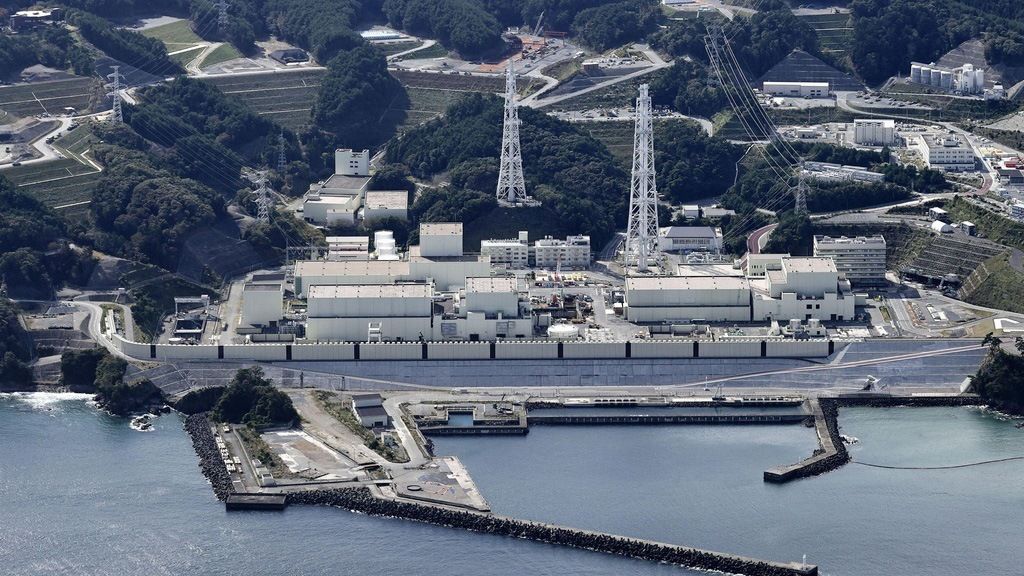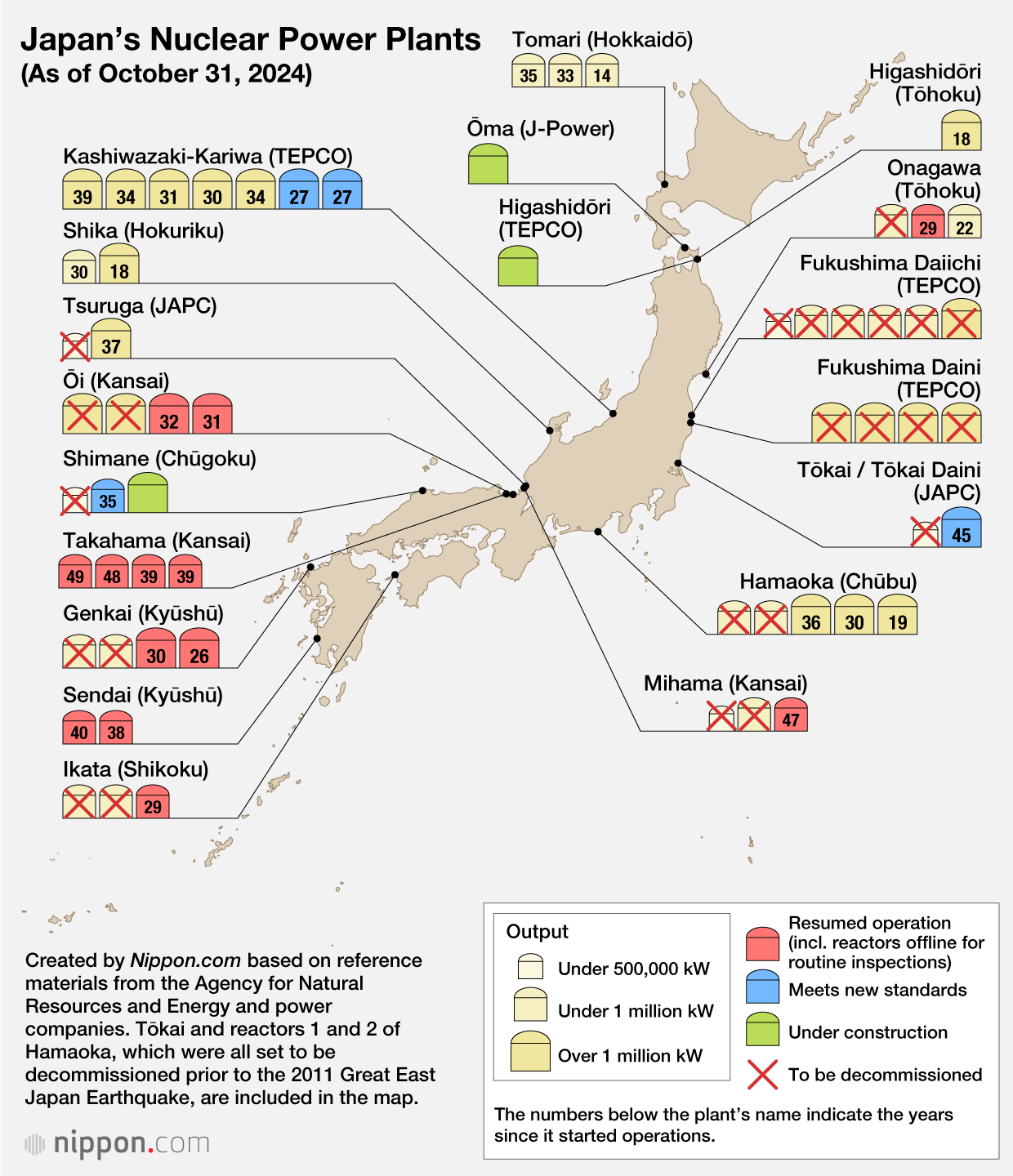
Japan’s Nuclear Power Plants in 2024
Economy Society Environment Politics- English
- 日本語
- 简体字
- 繁體字
- Français
- Español
- العربية
- Русский
On October 29, 2024, Tōhoku Electric Power Company brought the number 2 reactor at Onagawa Nuclear Power Station in Miyagi Prefecture back online, 13 years after it was shut down following the March 2011 Great East Japan Earthquake and subsequent Fukushima Daiichi Nuclear Power Station accident. Due to its long idle period, it will be halted on November 7 for checks on the facility before being restarted again around December when it will begin commercial operations.
Prior to the 2011 disaster, 54 nuclear reactors were in operation in Japan, supplying approximately 30% of the country’s electric power. More than 13 years later, in October 2024, only 13 reactors have been restarted with local approval at the following seven power stations: Ōi, Takahama, and Mihama (Kansai Electric Power Company), Genkai and Sendai (Kyūshū Electric Power Company), Ikata (Shikoku Electric Power Company), and Onagawa (Tōhoku Electric Power Company).
Previously only plants based in western Japan had resumed operations; these use pressurized water reactors, which are different from the boiling water reactors at Fukushima Daiichi. Onagawa is the first plant with boiling water reactors to go back online.
Nuclear Power Plants: Major Developments Since the Great East Japan Earthquake
December 2024 The number 2 reactor at Shimane Nuclear Power Station (Chūgoku Electric Power Company) is set to restart. It will be the second plant with boiling water reactors to resume operation.
October 2024 The number 2 reactor at Onagawa Nuclear Power Station (Tōhoku Electric Power Company) resumes operation. It is the first plant in eastern Japan to restart after the 2011 Great Eastern Japan Earthquake.
October 2024 The Nuclear Regulation Authority approves Kansai Electric Power Company’s plans to continue operating Takahama Nuclear Power Station in Fukui Prefecture, Japan’s oldest nuclear plant, which will have been in use for 50 years in November 2024. It is the first time for a plant to receive approval to operate for more than 50 years under the present system.
August 22, 2024 Tokyo Electric Power Company begins preparatory work for experimental removal of melted nuclear debris at Fukushima Daiichi Nuclear Power Station, but stops work after discovering an error in procedures. It restarts efforts in September, but issues with cameras attached to the device being used lead to a second stoppage. In late October, it starts work again.
September 2023 Restart of the number 2 reactor at Takahama Nuclear Power Station (Kansai Electric Power Company), which first started operating 47 years earlier.
August 24, 2023 Start of release of treated water containing radioactive tritium that had accumulated at the number 1 reactor of Fukushima Daiichi Nuclear Power Station.
September 2023 The number 2 reactor at Takahama Nuclear Power Station (Kansai Electric Power Company), which first started operating 47 years ago, is set to restart.
Summer 2023 Scheduled start of release of treated water containing radioactive tritium that has accumulated at the number 1 reactor of Fukushima Daiichi.
July 2023 The number 1 reactor at Takahama Nuclear Power Station, which first started operating 48 years ago, resumes operation after a 12-year hiatus.
July 2023 The International Atomic Energy Agency publishes a comprehensive report concluding that the planned release of treated water into the sea from TEPCO’s Fukushima Daiichi site is “consistent with international safety standards.”
May 2023 The GX Decarbonization Power Supply bill is enacted. In order to ensure stable power supply and achieve decarbonization, significant changes are made to the safety regulations stipulating that the operating period for reactors is “40 years in principle and a maximum of 60 years,” making it possible for them to operate for periods of longer than 60 years.
June 2022 Shimane Prefecture Governor Maruyama Tatsuya approves the restarting of the Shimane Nuclear Power Station (Chūgoku Electric Power Company).
June 2021 Mihama Nuclear Power Station (Kansai Electric Power Company) restarts operation for the first time since being shut down for routine inspection a decade before. At 44 years since it began operation, it is the first nuclear plant to restart despite being more than 40 years old.
April 2021 Fukui Governor Sugimoto Tatsuji announces his approval for restarting Mihama reactor 3 and Takahama reactors 1 and 2, which have all been operated by Kyūshū Electric Power Company for over 40 years. This is the first time since the accident at Fukushima Daiichi for local authorities to approve the restart of a nuclear power plant beyond its 40-year lifespan.
April 2021 The Nuclear Regulatory Commission officially decides to issue a corrective action order prohibiting the movement of nuclear fuel within the Kashiwazaki-Kariwa Nuclear Power Station until additional inspections confirm that issues have been resolved. Preparations to restart reactors are halted.
April 2021 The government decides to dilute the water containing tritium that continues to accumulate at Fukushima Daiichi before discharging the treated water into the ocean.
March 2021 The Nuclear Regulation Authority announces that the intruder detection system at Kashiwazaki-Kariwa Nuclear Power Station had not been functioning since March 2020 and that adequate alternative measures were not taken.
January 2021 It is discovered that there was unauthorized use of an employee ID card to enter the central control room at Kashiwazaki-Kariwa in September 2020.
December 2020 The Osaka District Court rules to cancel permission to resume operation of the number 3 and number 4 reactors at Ōi Nuclear Power Station. The Japanese government appeals the ruling.
November 2020 Miyagi Governor Murai Yoshihiro gives approval for Onagawa Nuclear Power Station (Tōhoku Electric Power Company) to resume operation. This is the first approval for a boiling water reactor, the same type as those at the Fukushima Daiichi plant where the accident occurred. Tōhoku Electric Power Company aims to start operation after fiscal 2020.
July 2018 The cabinet approves the fifth energy basic plan with the intention to have nuclear power account for 20%–22% of power generation in 2030.
March/June 2018 The number 3 and number 4 reactors at Genkai Nuclear Power Station (Kyūshū Electric Power Company) resume operation.
March/May 2018 The number 3 and number 4 reactors at Ōi Nuclear Power Station resume operation.
August 2016 The number 3 reactor at Ikata Nuclear Power Station (Shikoku Electric Power Company) resumes operation.
January/February 2016 The number 3 and number 4 reactors at Takahama Nuclear Power Station (Kansai Electric Power Company) resume operation.
August/October 2015 The number 1 and number 2 reactors at Sendai Nuclear Power Station (Kyūshū Electric Power Company) resume operation. These are the first restarts since the introduction of the new standards and follow almost two years without nuclear power in Japan.
April 2014 The cabinet approves the fourth energy basic plan, positioning nuclear power plants as an important base-load power source, while also pledging to reduce dependency on nuclear power as much as possible by introducing renewable energy.
September 2013 The number 3 and number 4 reactors at Ōi Nuclear Power Station undergo regular inspection and nuclear power generation drops back to zero.
July 2013 New regulatory standards relating to natural disasters and terrorist attacks introduced for nuclear power plants.
September 2012 Nuclear Regulation Authority established.
July 2012 The number 3 and number 4 reactors at Ōi Nuclear Power Station (Kansai Electric Power Company) resume operation, ending a 2-month period of no nuclear power generation in Japan.
June 2012 The operating period of nuclear power plants is limited to 40 years in principle.
May 2012 Tomari Nuclear Power Station (Hokkaidō Electric Power Company) suspends operation of its number 3 reactor. For the first time in 42 years there are no nuclear power plants operating within Japan.
March 2011 Great East Japan Earthquake and TEPCO Fukushima Daiichi Nuclear Power Station accident take place.
(Translated from Japanese. Banner photo: Onagawa Nuclear Power Station in Miyagi Prefecture. Photograph taken on October 24, 2024. © Kyōdō.)

